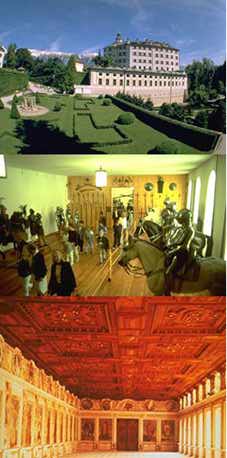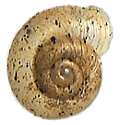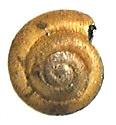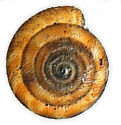The Castle of Ambras
by
Helmut Nisters, Austria
|
After an introduction to the Castle's fascinating history,
the tiny landshells that can be found in the grounds are
illustrated. The techniques described can be used to find
and study tiny landshells in your own area.
South-East from the center of Innsbruck in the midst of a
large park is situated the famous Castle Ambras in Renaissance
style. The Tirolean Sovereign, Archduke Ferdinand II (1529 -
1595), gave instructions to finish it as both his residential
castle and a museum. The present Art
and Historical Museum now displays the collections of this
generous patron of the Habsburger.
 You can see three armouries, as well as a
chamber for art and "curiosities". In the
"Hochschloss" you can find the portrait gallery of the
"Habsburger" with the portraits beginning from Duke
Albrecht III (1349-1395) up to Emperor Franz I (1768-1835) and
those of their relatives of the European dynasties. On the
ground-floor is situated the collection of late mediaeval images
(sculptures, paintings etc.), of which the most important and the
showpiece is the Georgsaltar of Emperor Maximilian I (1459-1519).
You can see three armouries, as well as a
chamber for art and "curiosities". In the
"Hochschloss" you can find the portrait gallery of the
"Habsburger" with the portraits beginning from Duke
Albrecht III (1349-1395) up to Emperor Franz I (1768-1835) and
those of their relatives of the European dynasties. On the
ground-floor is situated the collection of late mediaeval images
(sculptures, paintings etc.), of which the most important and the
showpiece is the Georgsaltar of Emperor Maximilian I (1459-1519).
Click on the image right to see a larger view
of the Castle and grounds.
The central court is decorated with ornate mural paintings, a
rarity is the bathroom of Philippine Welser. At the foot of the
"Hochschloss" Ferdinand II had the Spanischen Saal
built. In this 40 m long representation hall the "Ambraser
Schlosskonzerte" takes place every summer.
As many British enjoy the Dracula-myth, I want to mention that
among the portraits there is one of the Count Vlad Tzepesch IV
(15th century), the impaler, son of Count Vlad Dracul, and
notorious for his atrocities. This painting from the 16th century
is a copy of the oldest original (15th century).
That's what you can admire, when you are visiting the Castle
Ambras. But nevertheless you can find a lot of things, which
initially are not to be discovered with the unaided eye. You
don't believe me? I am speaking of several nice and interesting
creations by Nature and not by human beings, which are living on
an ivy-covered wall of this park, which Archduke Karl Ludwig had
built in the 19th century: some landshells.
Many of these snails are so small (about 1 - 3 mm) that we
call them microshells. They live well hidden in leaf mould and
earth among the roots of ivy. So when we want to collect them to
integrate them into a collection, we can't collect them as normal
sized shells but only by hand or by using tweezers. We have to
take a lot of this leaf mould and earth to check it at home using
magnifiers, as a lens or microscope. This is sometimes quite hard
and time-consuming work, as we have first to sieve the leaf mould
and earth with a sieve (riddle) at the place where we found it,
to separate it from rougher material, such as stones, roots,
leaves etc.
This so called "Gesiebe" (in German) we bring home
to sieve it again from one to three scales, from rough to very
fine using sieves with different wire-nettings to sort out later
our beloved microshells. If the leaf mould is too moist, we have
to let it dry near a window or at a not too shadowy place. In the
rougher material you can just sort out Clausiliidae as:
Clausilia dubia dubia (Draparnaud, 1805)
Laciniaria plicata plicata (Draparnaud, 1801)
Balea biplicata biplicata (Montagu, 1803)
and Discus rotundatus (O. F. Müller, 1774) (Fam.
Discidae).
In the finer material you can find the other tiny shells:
Vertiginidae, Valloniidae and Punctidae (Punctum pygmaeum
(Draparnaud, 1801), is our smallest European landshell).
As my mother, Irmgard Nisters, aged nearly 88 years, cannot
always go out, it's my job to collect the "Gesiebe" for
her, which she prepares in the above mentioned way to sort out
the microshells. That's what makes her young and quite agile
again!
So that you don't overlook and miss any important microshell,
you should take only a small sample at a time from the material
being examined i.e. what you get can between two fingers and not
more. In this way my mother sorts out the shells using a lens,
fine tweezers (Leonhard-tweezers), a fine brush or a pencil and
even her spitted forefinger. After sorting I help identify the
shells under my stereo-microscope with magnifications from 10X to
40X.
As the shells are very fresh when collected or if recently dead,
I can just use them for our
collection without cleaning them. I don't like to clean them as
maybe I can ruin them. Otherwise you can put them in a cup of
water with a little washing up liquid as the housewives use for
their dishes for a few hours, rinse them afterwards and let them
dry. But afterward they often look worse than when in their
original dry condition. If they are living, you can put them into
a strong solution of alcohol (more than 70%) for a few days and
then let them dry. Then you can put them into your collection.
The shells found along the wall of the park of Castle Ambras
are:
 1. Vertigo pusilla O. F. Müller, 1774
(Fam. Vertiginidae)
1. Vertigo pusilla O. F. Müller, 1774
(Fam. Vertiginidae)
 2. Vertigo
pygmaea (Draparnaud, 1801) (Fam. Vertiginidae)
2. Vertigo
pygmaea (Draparnaud, 1801) (Fam. Vertiginidae)
 3. Vertigo
angustior Jeffreys, 1830 (Fam. Vertiginidae)
3. Vertigo
angustior Jeffreys, 1830 (Fam. Vertiginidae)
 4.
Truncatellina cylindrica (A. Frussac, 1807) (Fam.
Vertinidae)
4.
Truncatellina cylindrica (A. Frussac, 1807) (Fam.
Vertinidae)
 5. Pupilla
muscorum (Linnaeus, 1758) (Fam. Pupillidae)
5. Pupilla
muscorum (Linnaeus, 1758) (Fam. Pupillidae)
 6. Vallonia
costata costata (O. F. Müller, 1774) (Fam. Valloniidae)
6. Vallonia
costata costata (O. F. Müller, 1774) (Fam. Valloniidae)
 7. Vallonia
excentrica (Sterki, 1892) (Fam. Valloniidae)
7. Vallonia
excentrica (Sterki, 1892) (Fam. Valloniidae)
10. Laciniaria plicata plicata (Draparnaud, 1801)
(Fam. Clausiliidae)
11. Balea biplicata biplicata (Montagu, 1803) (Fam.
Clausiliidae)
12. Punctum pygmaeum (Draparnaud, 1801) (Fam.
Punctidae)
 our
smallest European landsnail
our
smallest European landsnail
13. Discus rotundatus (O. F. Müller) (Fam.
Discidae)
In some other parts and habitats e.g. in a small forest with a
few rocks, under vegetation and on other walls I've found the
following species.
 8. Ena montana (Draparnaud, 1801) (Fam.
Buliminidae)
8. Ena montana (Draparnaud, 1801) (Fam.
Buliminidae)
 under
vegetation on a small slope in a small forest
under
vegetation on a small slope in a small forest
 9. Clausilia
dubia dubia Draparnaud, 1805 (Fam. Clausiliidae)
9. Clausilia
dubia dubia Draparnaud, 1805 (Fam. Clausiliidae)
14. Helix pomatia Linnaeus, 1758 (Fam. Helicidae)
 our largest
Tirolean landshell.
our largest
Tirolean landshell.
Thumbnail images of the shells (not to scale,
max. dimension given).
Numbers refer to species above.
Click here to view a page of larger
images with scale bars.

1. 1.8mm |

2. 1.8mm |

3. 1.7mm |

4. 1.8mm |

5. 3.2mm |

6. 2.3mm |

7. 2.3mm |

8. 13.5mm |

9. 12.5mm |

10. 17.5mm |

11. 15.5mm |

12. 1.3mm |
| |

13. 5.4mm |

14. 21mm |
|
Comments to the author Helmut Nisters are
welcomed. Contact details below (work/home):
Natural
History Department of the Tiroler Landesmuseum
Ferdinandeum Innsbruck,
Malacological Collection,
Feldstr. 11a,
A-6020 Innsbruck, Austria, Europe.
Phone: 0043 512 58 72 86 37. |
Helmut
Nisters
Franz-Fischer-Str. 46
A-6020 Innsbruck, Austria, Europe
Phone and Fax: 0043 512 57 32 14
E-mail: www.helix@ibk.netwing.at
URL: www.netwing.at/nisters/ |
Visitors' information for the Castle of Ambras:
Castle e-mail: schloss.ambras@khm.at
Website:http://www.khm.at
Telephone: 0043 512 34 84 46.
Visiting times:
1st Apr - 31st Oct:  Wed - Mon: 10.00 - 17.00 Wed - Mon: 10.00 - 17.00
1st Dec - 31st Mar: Wed - Mon: 14.00 - 17.00 |
Acknowledgements. Thank you to
Michael Gilhaus of the Tirol Tourism Office for permission to use
the Castle of Ambras images.
Editor's note: Helmut has
generously offered a wide range of smaller landshells to
Micscape, many of which can be widely found in Europe, and we
will be compiling an on-line illustrated resource in the coming
months using Helmut's and his mother Irmgard's extensive
experience. We hope this will become a valuable on-line resource
to encourage readers to search for microscopic landshells in
their own area.
Digital image capture details:
small shells taken with Panasonic CL350 video
camera with 50mm Nikon SLR lens and extension tubes. Helix shell
taken with Fuji DX-10 digital camera in macro mode.
Article prepared for the Web
by David Walker. Images by David Walker from shells
kindly supplied and identified by Helmut Nisters.
URL: hnambras
© Microscopy UK or their
contributors.
Published in the June 1999
edition of Micscape Magazine.
Please report any Web problems
or offer general comments to the Micscape Editor,
via the contact on current Micscape Index.
Micscape is the on-line monthly
magazine of the Microscopy UK web
site at http://www.microscopy-uk.co.uk
WIDTH=1
© Onview.net Ltd, Microscopy-UK, and all contributors 1995 onwards. All rights
reserved. Main site is at www.microscopy-uk.org.uk with full mirror at www.microscopy-uk.net.
 You can see three armouries, as well as a
chamber for art and "curiosities". In the
"Hochschloss" you can find the portrait gallery of the
"Habsburger" with the portraits beginning from Duke
Albrecht III (1349-1395) up to Emperor Franz I (1768-1835) and
those of their relatives of the European dynasties. On the
ground-floor is situated the collection of late mediaeval images
(sculptures, paintings etc.), of which the most important and the
showpiece is the Georgsaltar of Emperor Maximilian I (1459-1519).
You can see three armouries, as well as a
chamber for art and "curiosities". In the
"Hochschloss" you can find the portrait gallery of the
"Habsburger" with the portraits beginning from Duke
Albrecht III (1349-1395) up to Emperor Franz I (1768-1835) and
those of their relatives of the European dynasties. On the
ground-floor is situated the collection of late mediaeval images
(sculptures, paintings etc.), of which the most important and the
showpiece is the Georgsaltar of Emperor Maximilian I (1459-1519).









